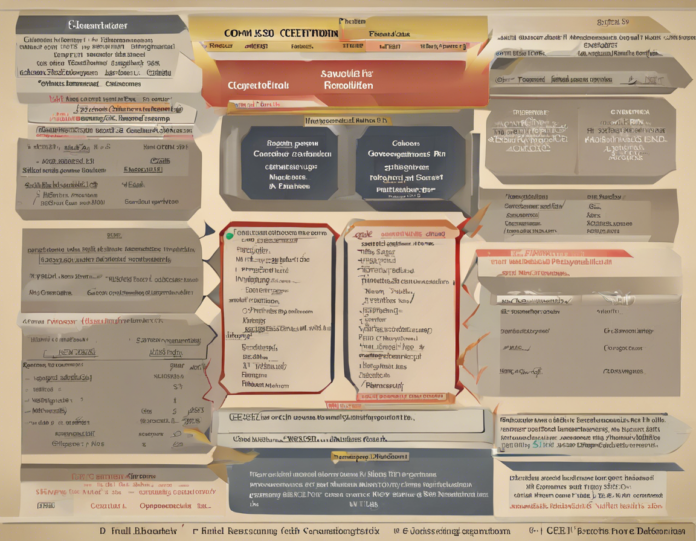The term CECA stands for the Comprehensive Economic and Trade Agreement. It is a free trade agreement between Canada and the European Union (EU) that aims to facilitate trade and investment between the two parties. The agreement was signed in October 2016 after seven years of negotiations, and it entered into provisional application in September 2017. Once fully implemented, it will eliminate tariffs on almost all goods and services traded between Canada and the EU, making it one of the most comprehensive trade agreements ever negotiated by both parties.
Benefits of CECA
The Comprehensive Economic and Trade Agreement (CECA) offers several benefits to both Canada and the European Union:
1. Increased Market Access
- CECA eliminates tariffs on a wide range of goods and services, providing businesses with greater access to each other's markets.
2. Enhanced Investment Opportunities
- The agreement includes provisions that protect and promote foreign investment, giving businesses on both sides more confidence to invest in each other's economies.
3. Regulatory Cooperation
- CECA encourages regulatory cooperation between Canada and the EU, aiming to reduce barriers to trade and promote compatibility in standards and regulations.
4. Intellectual Property Rights
- The agreement strengthens intellectual property rights, providing better protection for innovations and creations in both jurisdictions.
5. Sustainable Development
- CECA includes commitments to promote sustainable development, labor rights, and environmental protection, ensuring that trade benefits all stakeholders.
Key Provisions of CECA
The Comprehensive Economic and Trade Agreement (CECA) includes several key provisions that impact trade and investment between Canada and the European Union:
1. Tariff Elimination
- CECA eliminates tariffs on 98% of goods traded between Canada and the EU, making it easier and cheaper for businesses to export and import products.
2. Services and Investment
- The agreement opens up opportunities in the services sector, allowing companies to provide services more easily across borders and facilitating investment flows between the two parties.
3. Government Procurement
- CECA gives Canadian and EU companies access to each other's government procurement markets, providing more opportunities to compete for public contracts.
4. Intellectual Property
- The agreement strengthens intellectual property protections, including patents, trademarks, and copyrights, to ensure that innovations and creations are adequately safeguarded.
5. Regulatory Cooperation
- CECA promotes regulatory cooperation to reduce unnecessary barriers to trade, streamline procedures, and enhance compatibility in standards and regulations.
Challenges and Criticisms of CECA
While the Comprehensive Economic and Trade Agreement (CECA) offers numerous benefits, it has faced some challenges and criticisms:
1. Regulatory Barriers
- Despite efforts to reduce regulatory barriers, differences in standards and regulations between Canada and the EU can still pose challenges for businesses.
2. Impact on Agriculture
- The agricultural sector has raised concerns about increased competition and the potential impact on domestic producers, especially in sectors heavily protected by tariffs.
3. Environmental and Labor Standards
- Critics argue that the agreement could lead to a race to the bottom in terms of environmental and labor standards, as companies might seek to cut costs by moving production to jurisdictions with lower regulations.
4. Investor-State Dispute Settlement (ISDS)
- The inclusion of an Investor-State Dispute Settlement mechanism in CECA has been criticized for potentially undermining national sovereignty and favoring the interests of multinational corporations.
5. Transparency and Public Consultation
- Some critics have raised concerns about the lack of transparency and public consultation during the negotiation process of CECA, arguing that the agreement should have undergone more scrutiny and input from civil society.
Frequently Asked Questions (FAQs) about CECA
1. What is the difference between CETA and CECA?
- CETA stands for the Comprehensive Economic and Trade Agreement and refers to the same trade deal between Canada and the EU as CECA. The terms are used interchangeably.
2. How does CECA benefit small businesses?
- CECA benefits small businesses by reducing barriers to trade, providing access to new markets, and creating a more level playing field for competing with larger companies.
3. Does CECA apply to services as well as goods?
- Yes, CECA covers both goods and services, aiming to liberalize trade in all sectors of the economy between Canada and the EU.
4. Is CECA fully implemented?
- While CECA entered into provisional application in September 2017, some provisions are still being phased in, and full implementation is expected to occur over several years.
5. How does CECA promote sustainable development?
- CECA includes commitments to promote sustainable development by incorporating provisions on labor rights, environmental protection, and social responsibility into the agreement.
6. What sectors stand to benefit the most from CECA?
- Sectors such as manufacturing, agriculture, services, and technology are expected to benefit significantly from CECA due to increased market access and reduced trade barriers.
7. Can CECA be expanded to include other countries?
- While CECA is a bilateral agreement between Canada and the EU, there is potential to expand its scope to include other countries or regions in the future through additional negotiations.
8. How does CECA impact intellectual property rights?
- CECA strengthens intellectual property rights by providing better protection for patents, trademarks, copyrights, and trade secrets, encouraging innovation and creativity.
9. What mechanisms are in place to resolve disputes under CECA?
- CECA includes a dispute settlement mechanism to address conflicts between parties, including consultation and mediation procedures before resorting to formal arbitration.
10. How can businesses take advantage of CECA?
- Businesses can take advantage of CECA by understanding its provisions, seeking information and support from trade authorities, and exploring new opportunities for trade and investment with EU partners.
In conclusion, the Comprehensive Economic and Trade Agreement (CECA) between Canada and the European Union represents a significant milestone in promoting trade and investment between the two parties. While facing challenges and criticisms, the agreement offers substantial benefits for businesses, consumers, and economies on both sides. By fostering closer economic ties, CECA has the potential to drive growth, create new opportunities, and strengthen the partnership between Canada and the EU in the years to come.


Recent comments